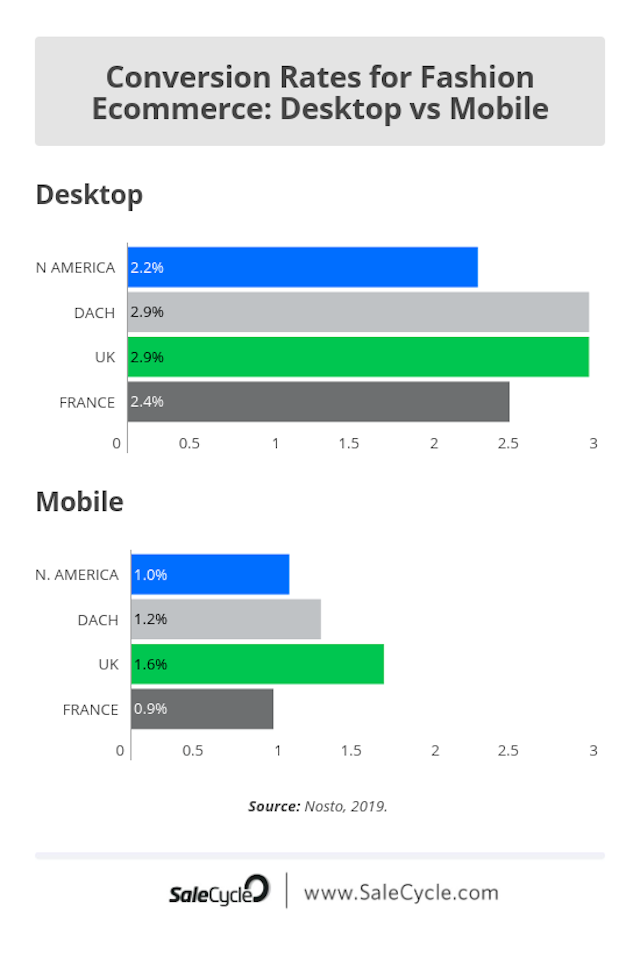Why are mobile conversion rates lower than desktop?
Smartphone traffic now accounts for the majority of visits to retailers, but mobile conversion rates lag behind desktop. We take a look at the reasons for this.

/ Photo by William Iven on Unsplash.
A decade on from the release of the first iPhone, mobile shopping is massive. Much of this is thanks to Apple, and the many smartphones which followed, but there are still obstacles for retailers to overcome.
According to stats from Monetate, smartphone traffic worldwide to retailers is at 56.2%, and 34.5% for desktop.
However, this mobile traffic is converting at less than half the rate of that on desktop, at 2.25% compared to 4.81% for desktop. Even tablet fares better, converting at 4.06% on average.
We’ve seen the same pattern in our own stats. Around half of all visits to retailer’s sites come from mobile, but just 36% of purchases take place on mobile.

It seems that people are happy to browse on mobile, but many still prefer to buy on desktop, so let’s look at the reasons why.
There are several reasons why people prefer to buy on a laptop or PC. For one, it can be easier to navigate around the site and view images on a bigger screen, so some shoppers may browse on mobile and select products later on.
People are also more likely to buy on desktop when purchases are more complex. Travel purchases are generally more expensive and complicated – only 18% complete bookings on mobile.
Much of the issue comes down to checkout. Indeed, the add to cart rates shown above suggest this. While mobile conversion rates are less than half that of desktop, add to cart rates aren’t so far behind.
Even in sectors where shoppers are more likely to use mobile, such as fashion, mobile conversion rates still lag behind desktop.
Fashion sites attract a greater proportion of sales on mobile. In fact, this is the only sector to attract the majority of its sales from mobile shoppers (51.39%).
However, data from our recent Fashion Ecommerce Trends Report finds that fashion conversion rates are almost twice as high on desktop when compared to mobile.

Mobile usability on fashion sites has improved greatly, but some customers are still reluctant to convert via mobile devices.
The average mobile add to cart rate is 10.4%, compared to 12.9% for desktop. This implies that people are adding items to their cart at similar rates, but many more are bailing out during checkout.
The biggest issue behind lower mobile conversions is the checkout. So how can checkout be made easier? Here are three ways to do this…
People hate registering before they begin a purchase, and it seems like hard work for mobile shoppers, so providing a guest checkout option is one way to improve conversion rates.

It’s a barrier for customers, and one that isn’t necessary, as they can complete registration after purchase anyway. Streamlining forms makes checkout easier and faster, reducing hassle for shoppers, and removing sources of friction where people might abandon checkout.
Sites can allow users to autofill address and payment details saved on their phone’s browser, or postcode lookup tools to reduce the number of steps customers need to take.
Small details matter, such as defaulting to the most appropriate smartphone keyboard, like the numeric version for entering payment card details. It’s about making it easier for customers through marginal improvements.

Payment methods matter too, and providing alternatives can make it easier for mobile shoppers. Card details take time to enter, but PayPal and digital wallet options like Apple Pay can make payment fast and smooth.

Mobile is a challenge for retailers, but now that customers have shown they’re willing to browse and buy on mobile, it’s all about making the payment process smooth and easy for shoppers.
Graham Charlton is editor in chief at SaleCycle
Content by The Drum Network member:

SaleCycle
Founded in 2010, SaleCycle is committed to helping the world’s top brands recover lost sales online.
We work with companies to help inspire, shape and support...
